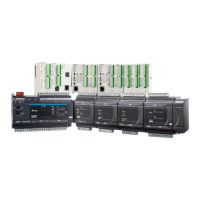DVP-ES3/EX3/SV3/SX3 Series Hardware and Operation Manual
Since ISPSoft and DIADesigner are similar in terms of program editing, this chapter will use ISPSoft software
as an example for explanation. Refer to Chapter 6 of the DIADesigner User Manual for information related to
DIADesigner software.
10.1 Introduction to CANopen
1. Because of its simple wiring, immediate and stable communication, strong debugging ability, and low
cost, the CANopen network is widely used in fields such as industrial automation, the automotive industry,
the medical equipment industry, and the building trades.
2. The DVP-ES3/EX3/SV3/SX3 Series PLC is equipped with CANopen communication port. The CAN port
conforms to the basic communication protocol CANopen DS301. It supports master and slave modes.
3. This chapter explains the functions of CANopen. In master mode, CANopen can support up to 64 slaves.
4. CANopen Builder is the CANopen network configuration software for the DVP-ES3/EX3/SV3/SX3 Series.
You set the CANopen station address and the communication rate with this software.
ISPSoft/DIADesigner is the programming software for the DVP-ES3/EX3/SV3/SX3 Series.
5. This chapter mainly focuses on the CANopen functions. Refer to Section 10.3 for more information.
10.1.1 CANopen Function Descriptions
The CAN port has the following functions when acting as a master.
1. It supports the standard CANopen protocol DS301 V4.02.
2. It supports the NMT (network management object) service.
It supports NMT state control.
Use NMT state control to control the state of a slave in the CANopen network.
It supports NMT error control.
Use NMT error control detect the disconnection of a slave. The NMT error control is classified into
two types; Heartbeat and Node Guarding. The DVP-ES3/EX3/SV3/SX3 Series PLC does not
support Node Guarding.
3. It supports the PDO (process data object) service.
Use PDO messaging to transmit immediate input and output data.
It supports up to 256 RxPDO and 1894 bytes.
It supports up to 256 TxPDO and 1894 bytes.
It supports synchronous and asynchronous modes for the PDO transmission type.
4. It supports the SDO (Service Data Object) service.
Use SDO to read, write, or configure the slave parameters.
It supports standard SDO transmission mode.
It supports automatic SDO functions. You can write up to 20 pieces of data to a slave.
It supports using the SDO service in a PLC ladder diagram to read the data from a slave or write
the data to a slave.

